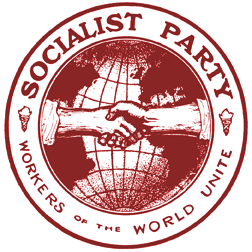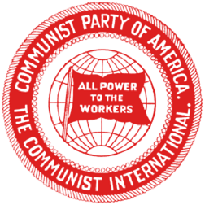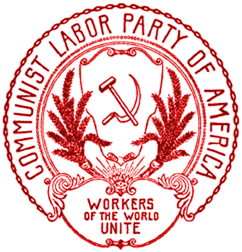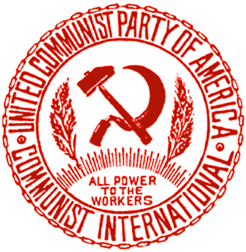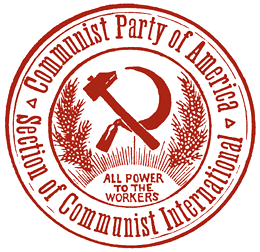GERMAN FEDERATIONS
German Language Federation of the Socialist Party
German immigrants comprised the major part of groups affiliated with the First International and later the Socialist Labor Party. German immigrants dominated the early American socialist political organizations and consequently it was only relatively late when the need was felt to organize a specific German language group within the party.
The “German Language Federation of the Socialist Party”was formed at the First National Convention of the German-speaking Socialists of the United States, held at New Castle, PA, on Dec. 27-28, 1912. A total of 32 delegates, (representing 90 branches with a claimed membership of 4,515) participated. Adolph Dreifuss was elected the first Translator-Secretary of the organization for a two year term and a 7 member National Committee elected — one member being elected by each of 7 counties in New York and New Jersey with a strong German-language organiization. A Supervising Committee was also elected, charged with handling grievances within the Federation as well as the oversight of the Translator-Secretary and members of the National Committee.
[fn: Adolph Dreifuss, “Report of German Language Federation.”([Chicago]: [Socialist Party of America], [1913]).]
The German Federation so organized began its work in the National Office in Chicago on March 1, 1913.
The German Federation of the SPA showed the following pattern of growth:
March - Aug. 1913 —————————- 3,620 members ave.
Sept. 1913 - Feb. 1914 —————— 4,738 members ave.
March - Aug. 1914 —————————- 5,100 members ave.
Sept. 1914 - Feb. 1915 —————— 4,257 members ave.
March - Aug. 1915 —————————- 4,117 members ave.
Sept. 1915 - Feb. 1916 —————— 4,,577 members ave.
In its first three years, the German Federation issued 7 pamphlets and published a book, The International in America by Hermann Schleuter, editor of the New Yorker Volkszeitung. The group brought Alexandra Kollontai to the United States for nearly four months to work as an organizer. Prominent speakers from the early years of the Federation included Oscar Ameringer, Max Bedacht, Ernest Untermann, and Emil Seidel, among others.
[fn: Adolph Dreifuss, “The Work of the German Language Federation SP”in The American Labor Year-Book, 1916. (NY: Rand School Press, 1916), pp. 133-134.]
On May 30-31, 1919, the 2nd National Convention of the German Socialist Federation was held in Rochester, NY. It was attended by about 35 delegates. The Convention’s most significant action was endorsement of the program of the Left Wing Section of the Socialist Party, which was approved by a vote of 29 to 4. A further motion to immediately affiliate with the Left Wing movement was defeated 24 to 10, with the majority of delegates seeking to maintain affiliation with the SPA. A resolution was also passed calling for affiliation of the Socialist Party with the Communist Interrnational.
[fn: “German Socialist Federation Convention Endorses Left Wing Program," in The Ohio Socialist, June 11, 1919, pg. 3.]
Executive Secretary of the German Federation of the Socialist Party up to the 1919 split was Ludwig Lore.
German Federation of the Communist Party of America
This decision of the Executive of the German Federation met with opposition from member branches. The first German branch to cross over and be chartered to the CPA’s new German Federation was that of St. Paul, Minnesota, followed by Minneapolis — the home turf of CPA Central Executive Committee member Charles Dirba. The German branch of Local Cuyahoga Co. (Ohio), the massive Socialist Party local formerly headed by C.E. Ruthenberg, was hotly contested, with the Executive Secretaries of both the CLP (Wagenknecht) and CPA (Ruthenberg) addressing a meeting of the branch for 45 minutes each; the meeting then voted 178 to 3 to affiliate with the new CPA German Federation. An additional 19 branches from Massachusetts voted to affiliate with the CPA as did various other branches located throughout the midwest and eastern United States.
Organizer of the CPA’s German Federation was Fritz “Fred”M. Friedman. In October of 1919 it began to issue a new German weekly, Die Kommunististische Internationale. By mid-November of 1919 approximately 30 German branches with a claimed membership of about 2500 had affiliated with the CPA.
[Source: C.E. Ruthenberg, “The Party Organization", in The Communist, new series v. 1, no. 2, Oct. 4, 1919, pg. 7; CEC minutes of Nov. 15, 1919 meeting, Comintern Archive: f. 515, op. 1, d. 7, l. 8.]
German Language-Group of the Communist Labor Party [Deutschen Sprachgruppe der Kommunistischen Arbeiterpartei]
Immediately after the split of the Socialist Party in 1919, the German Federation took up the issue of affiliation. In September, the National Executive of the Federation voted 41 to 8 to follow individual branches in New York and New Jersey into the the Communist Labor Party.
Gustav Wolf of Weehawken, NJ, served as the first Secretary of the CLP’s German Federation.
[fn: “Communist Labor Party National Office Bulletin”(Sep. 1919). In the Comintern Archive f. 515, op. 1, d. 6, l. 22.]
The German Language Group feature prominently Ludwig Lore. It published material from the address of the New Yorker Volkszeitung, located at 15 Spruce Street, New York.
It published at least one pamphlet: Warum für die Kommunistische Arbeiterpartei?
[fn: Copy in Comintern Archive, f. 515, op. 1, d. 24, l. 28-33].
German language organization of the United Communist Party
Some 61 of the UCP’s 673 primary party units ("Groups") were German speaking in December of 1920, according to the Party’s statistics, nearly 10% of the total number. These groups were spread across the east, with the largest number in New York, Chicago, and Cleveland.
[fn: DoJ/BoI Investigative Files, NARA M-1085, reel 940, doc. 501.]
German Federation of the unified Communist Party of America
In late 1921, during the 5 months between formation of the unified CPA and the split of the Central Caucus faction, the Communist Party’s German Federation had an average monthly paid membership of only 153, making it the 9th largest of the 10 Language groups in the party.
[Source: Comintern Archive: f. 515, op. 1, d. 75, l. 12.]
Downloads
1908
MAY
“Report of Committee on Foreign Speaking Organizations to the National Convention of the Socialist Party, May 17, 1908.” Committee report to the 1908 SPA Convention in Chicago, delivered by S.A. Knopfnagel. The Committee advocated the acceptance of all foreign language organizations seeking affiliation with the Socialist Party, subject to 5 conditions: “(1) They are composed of Socialist Party members only. (2) Any foreign speaking organization having a national form of organization of its own be recognized only if all the branches composing this organization having been chartered by the national, state, or local Socialist Party organizations, and pay their dues to the respective Socialist Party organizations. (3) No foreign speaking organization asking the Socialist Party for recognition shall issue their own particular national, state, or local charters. Same to be issued only by the respective organizations of the Socialist Party, as the case may require. (4) All foreign speaking organizations affiliated with the Socialist Party must and shall conform in every respect with the Socialist Party national, state, and local constitutions, platforms, and resolutions. (5) They should function only as agitation, education, and organization bureaus of the Socialist Party.”Includes an amendment made from the floor but not published in the SP’s Official Bulletin (probably due to incompetence rather than malice) prohibiting the refusal of admission to the SPA on account of race or language.
1913
MAY
“Report of the German Language Federation to the National Committee of the Socialist Party of America, May 1913,” by A. Dreifuss. The German Federation of the Socialist Party was organized late in December of 1912. This was the first report of Translator-Secretary Adolph Dreifuss to the 1913 plenum of the SPA’s governing National Committee. Details of the first National Convention and the size and structure of the federation are provided here. Difficulty with Local San Francisco over the new federation structure in the party is noted, with loss of dues revenue under the new system identified as probable cause for the difficulty.
DECEMBER
“United Communist Party — “Groups" According to Language: As of December 1920.”This is based upon an internal document of the United Communist Party captured by the Department of Justice’s Bureau of Investigation in the April 1921 raid on UCP National Headquarters in New York. The UCP prided itself on having largely eliminated the federation-based form of organization which typified its rival, the Communist Party of America. Groups (Primary Party Units of between 5 and 10 members) were nevertheless based around language as well as geography and statistics tabulated by the organization. This snapshot from the midpoint of the UCP’s one year of existence surprisingly shows more South Slavic (Croatian and Slovenian) language groups than any other (144), followed by the Russian (136), English (121), German (61), Latvian (49), Yiddish (37), Lithuanian (34), and Finnish (31) language groups.
undetermined date
“Membership Series by Language Federation for the Workers Party of America. ‘Dues Actually Paid’ — January to December 1923.” Official 1923 data set of the Workers Party of America, compiled from a document in the Comintern Archive. This series shows a great numerical dominance of the WPA by its Finnish Federation, accounting for a massive 42.8% of the average monthly paid membership of the organization (6,583 of 15,395). The total of the English language branches is the 2nd strongest amongst the federations (7.6%) followed by the South Slavic (7.5%), Jewish [Yiddish language] (6.9%), and Lithuanian (6.0%) Federations. In all, there were statistics kept for 18 different language groups of the WPA in 1923, including the English and the barely organized Armenian sections.
“Initiation Stamps Sold by Federation for the Workers Party of America. January to December 1923.” Official 1923 data set of the Workers Party of America, compiled from a document in the Comintern Archive. This series once again (repeating the previous published 1924 series) shows a schizophrenic pattern of stamp sales among language groups . Some federations clearly did not collect the initiation fees called for in the WPA constitution at all (Jewish, German, Latvian) while at the same time the quantities sold via the English branches are ridiculously high. Over 53% of the initiation stamps sold for the entire WPA were credited to the English branches — nearly three times as many initiations than there were average duespayers in those English branches! Even assuming a significantly higher than average “membership churn”rate for English branches, there is clearly some other unexplained phenomenon at play in these English branch initiation stamp sale figures...
undetermined date
“Membership Series by Language Federation for the Workers Party of America. ‘Dues Actually Paid’ — January to December 1924.” Official 1924 data set of the Workers Party of America, compiled from a document in the Comintern Archive. This shows a continued numerical dominance of the Workers Party of America by its Finnish-language federation, averaging a paid membership of 7100 (41% of the entire organization) for the year 1924. Impressive growth is shown by the Yiddish-language ("Jewish") federation, which moved to the third largest language group in the WPA in 1924. The English branches comprised the second largest language group in the WPA, but still remained just 11% of the overall organization. The South Slavic federation (predominately Slovenian and Croation) was the 4th largest language group in the WPA, topping the Russian, Lithuanian, and Ukrainian federations.
“Initiation Stamps Sold by Federation for the Workers Party of America. January to December 1924.” Official 1924 data set of the Workers Party of America, compiled from a document in the Comintern Archive. An extremely interesting monthly series in which two unexplained anomalies are apparent: (1) The failure of at least 8 of the WPA’s 18 language sections to make more than a token effort to collect the $1 initiation fee and obvious similar behavior (to lesser degree) among branches of other language groups; (2) A preposterously large sale of 5,264 initiation stamps to “English”branches, which averaged a paid membership of just 1909 over the course of the year. Either there was a revolving door in the English branches that was entirely dissimilar to the situation in any other language group of the WPA; or there was some sort of effort to collect initiation fees among “English”workers without organizational follow up; or there was some sort of strange accounting practice used by the WPA in which miscellaneous sales of initiation stamps were lumped into the “English”category (or some combination of these explanations). A perplexing question in raised, with further archival research clearly necessary.

